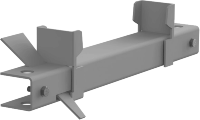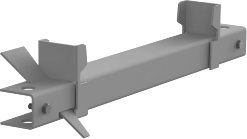To download our Site Installation Manual, please click on the link below
Site Installation Manual
KEY DESIGN REQUIREMENTS – Engineer’s Briefing Document
An installed ACO Drain System should incorporate the following:
- Correct channel type and size.
- Correct grate type (All grates must be fully locked down in trafficable applications).
- Correctly designed concrete encasement of minimum compressive strength 25 MPa.
It is the customer’s responsibility to ensure the concrete encasement is suited for the application and is designed/approved by the project’s engineer.
Systems are typically installed in concrete slabs, flexible pavements and block pavements. ACO Drain Systems must be encased in a concrete surround that is both durable and conform to at least the minimum dimensional requirements, shown in ACO’s recommended installation drawings.
Refer to ACO Drain Installation Drawings
These illustrations are a guide for average ground conditions only. Specific site conditions may require an increase in these dimensions and/or the addition of reinforcement.
If more than one pour is cast to form the concrete surround, each pour must be adequately bonded to the other. This is for structural continuity.
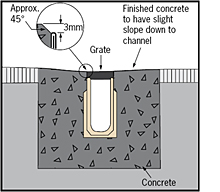 The top of the encasement adjacent to the pavement must be above the grate level (approximately 3mm), this ensures all liquids drain into the channel and that the channel edge is protected against direct traffic loads, see adjacent illustration (left). The same applies for pavements laid up to the channel edge.
The top of the encasement adjacent to the pavement must be above the grate level (approximately 3mm), this ensures all liquids drain into the channel and that the channel edge is protected against direct traffic loads, see adjacent illustration (left). The same applies for pavements laid up to the channel edge.
The encasement must be designed to support the channel system under load and isolate it from stresses derived from live loads and from the thermal movement of any adjacent slabs. Care must be taken during the curing regime to ensure no gaps appear between the drain channels and the encasement. Shrinkage reinforcement may be required.
Concrete Slabs
Expansion joints
Expansion joints are a cost effective way to cater for the thermal expansion of slabs. The joints are either longitudinal (running parallel to the channel haunch) or transverse (cutting across channel haunch and base) to the trench drain.
Longitudinal expansion joints should be continuous and flexible. The joints must be provided at a depth equal to the adjacent slab between the concrete encasement and adjacent slab, see illustrations below. The minimum distance between the channel edge and expansion joint may be varied to suit the concrete surround width up to a metre from the channel.
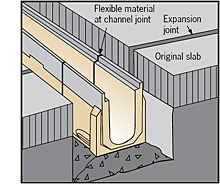 Transverse contraction/expansion joints (cutting across the trench run) to prevent surface cracking in the concrete slab may be required. Ideally, such joints should be positioned at channel joints. Alternatively, a cut may be made at the appropriate location along the channel and sealed with flexible sealant, see adjacent illustration (right).
Transverse contraction/expansion joints (cutting across the trench run) to prevent surface cracking in the concrete slab may be required. Ideally, such joints should be positioned at channel joints. Alternatively, a cut may be made at the appropriate location along the channel and sealed with flexible sealant, see adjacent illustration (right).
Dowels may be specified by the engineer if differential settlement is a concern. If the joint is dowelled, effective debonding should be provided. Dowels must be horizontal.

Reinforcement
The concrete encasement may require reinforcement for a number of reasons. Three common reasons are discussed below.
- The engineer may choose to reinforce the encasement to increase its flexural strength. This is not uncommon for long trench runs particularly if ground movement is anticipated.
- Reinforcement may also be incorporated for the control of cracking along the encasement.
- In concrete slabs if longitudinal expansion joints are not a practical solution, then the reinforcement design must be carefully considered.
Flexible Pavements
For applications up to Load Class D, asphalt can be applied directly up to channel edge, see illustrations below for concrete haunch details.
The channel edge should be protected before the application of asphalt as it is exposed at this stage of the installation and could be damaged.
CAUTION: When rolling asphalt, care should be taken not to damage channel edge or grate. Small asphalt paving machinery should be used in the area directly adjacent to the channel edge rail.
Block Pavements - Pavers
For applications up to Load Class D, pavers can be installed up to channel edge, see illustrations below for concrete haunch details.
The paver course adjacent to the channel MUST be fully bonded to the concrete haunch. The bonding prevents movement of pavers and possible damage to channel. Subsequent pavers, not in proximity to the trench drain, can be bedded on compacted sand.
The official installation guide can be downloaded at
http://www.acoaus.com.au/pdf/site_installation_manual.pdf
Click here for PDF version of this page
Installation devices are used to align channels to create a complete trench run. Once the installation is complete using these devices the concrete is poured around the device and channels. Installation devices allow a single concrete pour.
Installation Device Instructions
Installation Template Drawings
On-site fabrications are required whenever a trench is to form a corner or junction. All half meter polymer concrete channels have drill-out details on the side to aid the formation of corners and T junctions but all channels can be cut and fabricated to create the desired layout.
Note : When cutting sections of polymer concrete channel, protective eyeglasses, gloves and a respirator mask are recommended.
T junctions
T junctions are when an opening is cut into the side of one channel and another channel is butted up to this opening
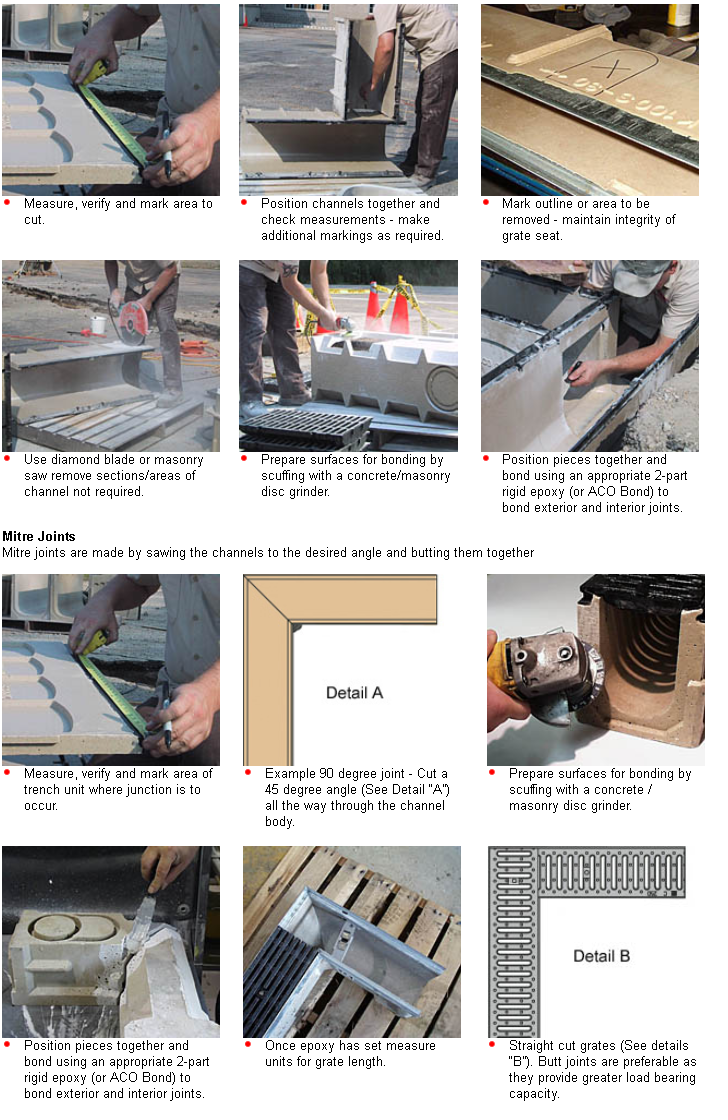





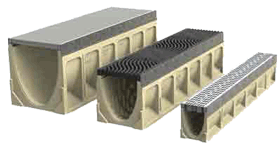 300mm internal width
300mm internal width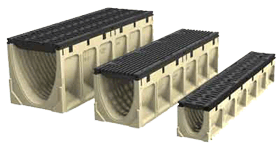 300mm
internal width
300mm
internal width



 ACO RESOURCES
ACO RESOURCES The top of the encasement adjacent to the pavement must be above the grate level (approximately 3mm), this ensures all liquids drain into the channel and that the channel edge is protected against direct traffic loads, see adjacent illustration (left). The same applies for pavements laid up to the channel edge.
The top of the encasement adjacent to the pavement must be above the grate level (approximately 3mm), this ensures all liquids drain into the channel and that the channel edge is protected against direct traffic loads, see adjacent illustration (left). The same applies for pavements laid up to the channel edge.
 Transverse contraction/expansion joints (cutting across the trench run) to prevent surface cracking in the concrete slab may be required. Ideally, such joints should be positioned at channel joints. Alternatively, a cut may be made at the appropriate location along the channel and sealed with flexible sealant, see adjacent illustration (right).
Transverse contraction/expansion joints (cutting across the trench run) to prevent surface cracking in the concrete slab may be required. Ideally, such joints should be positioned at channel joints. Alternatively, a cut may be made at the appropriate location along the channel and sealed with flexible sealant, see adjacent illustration (right). 



